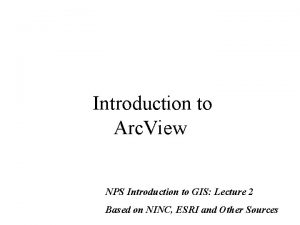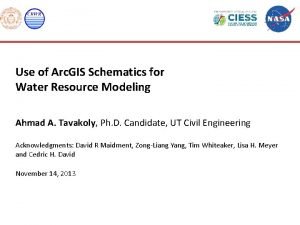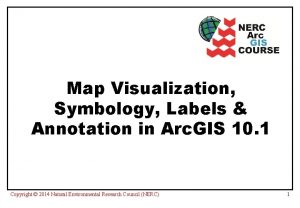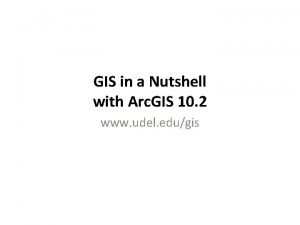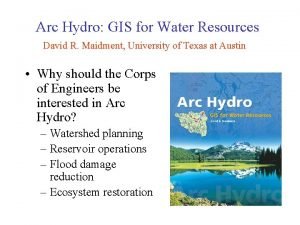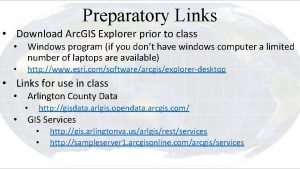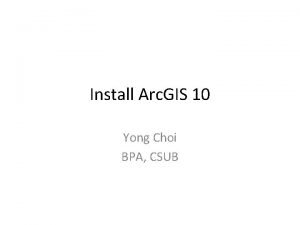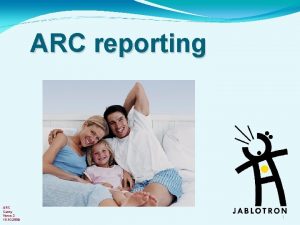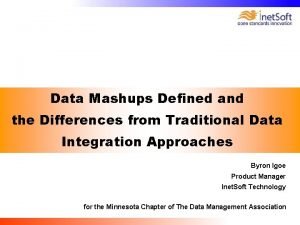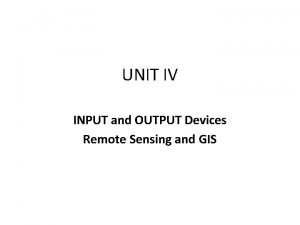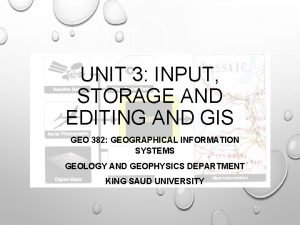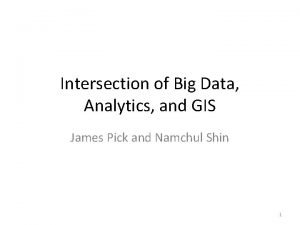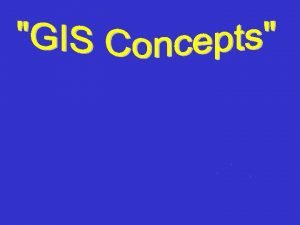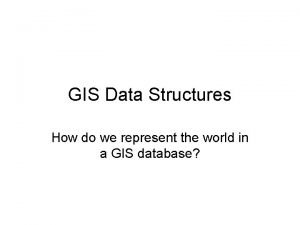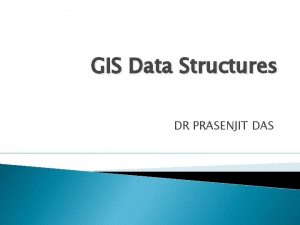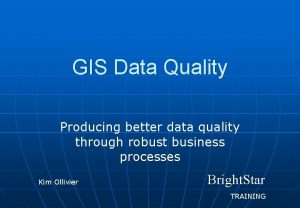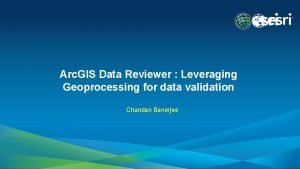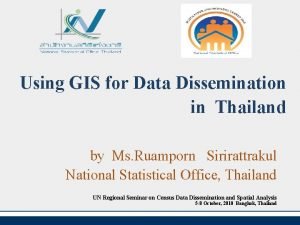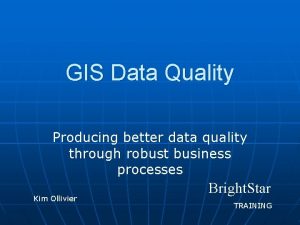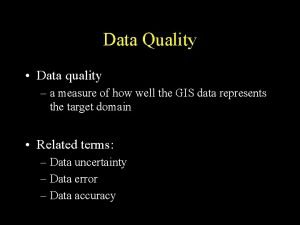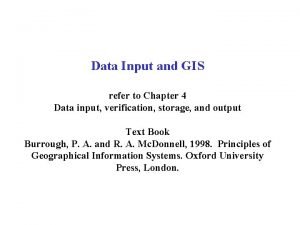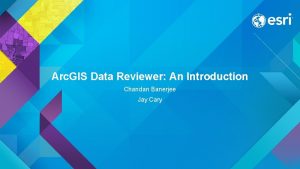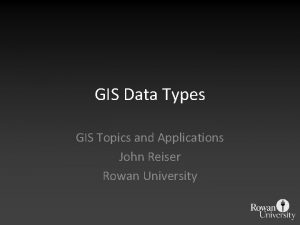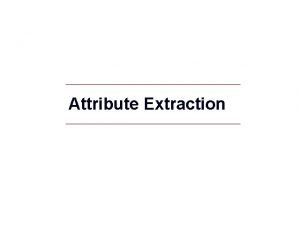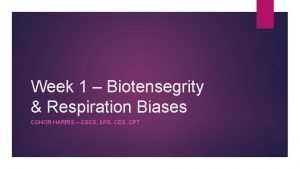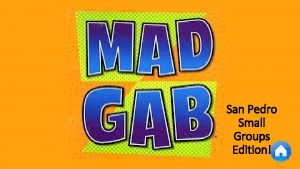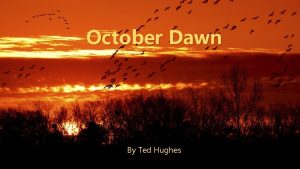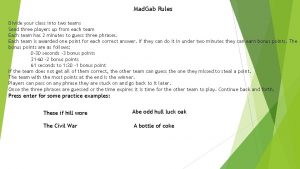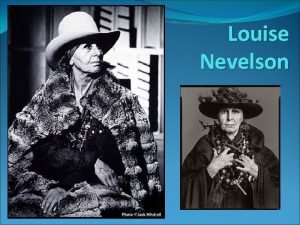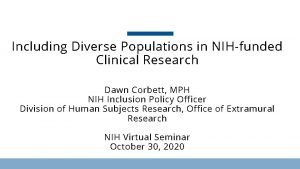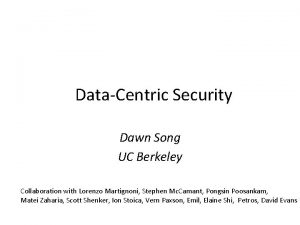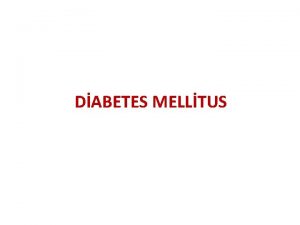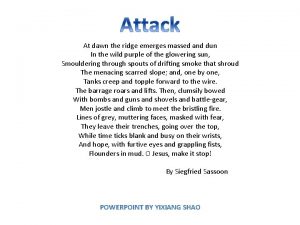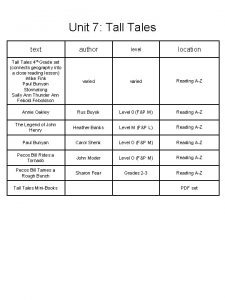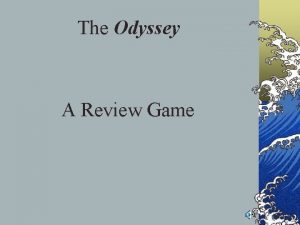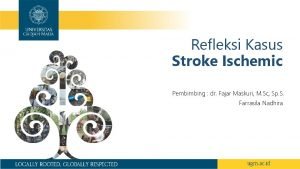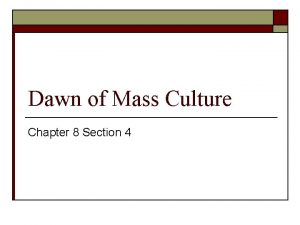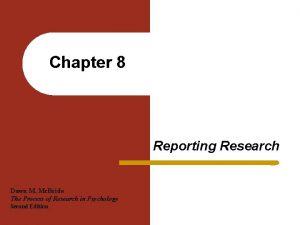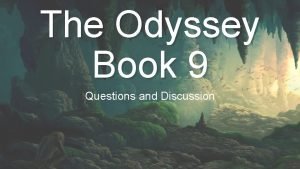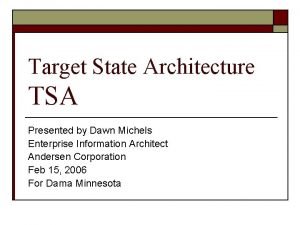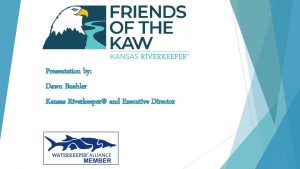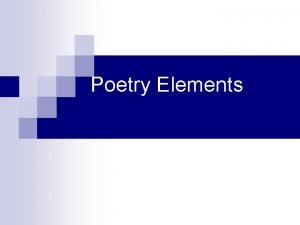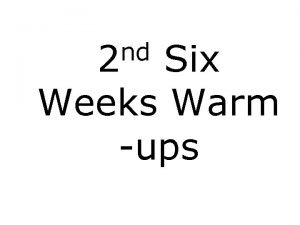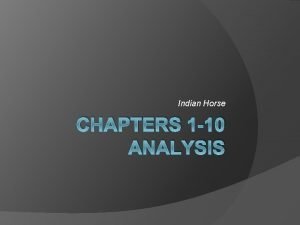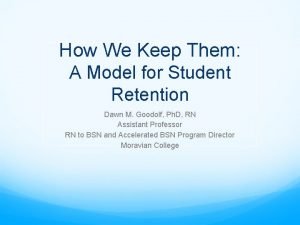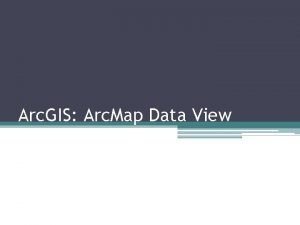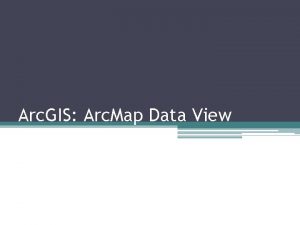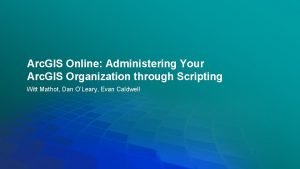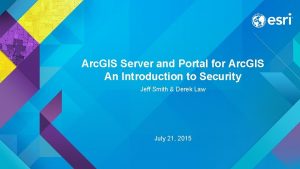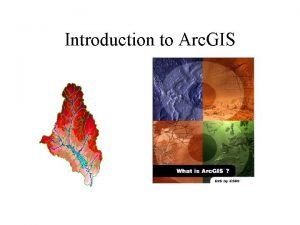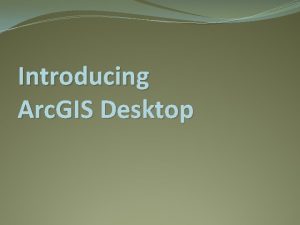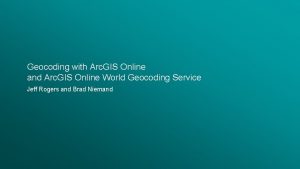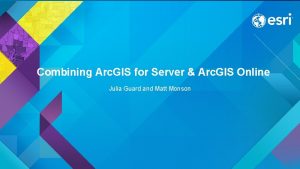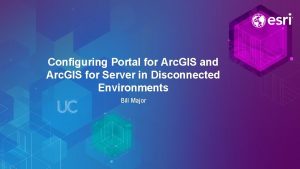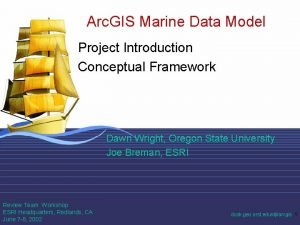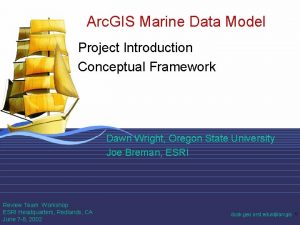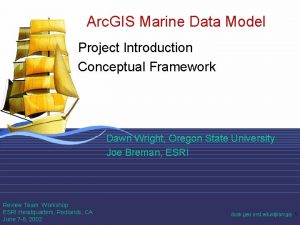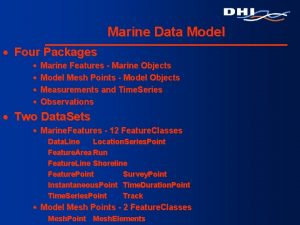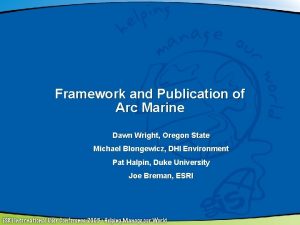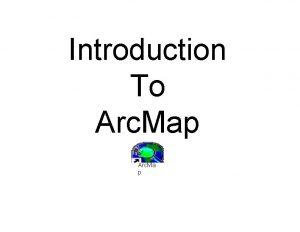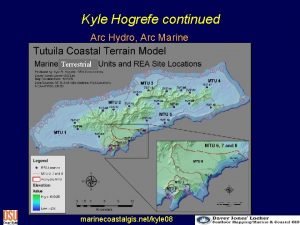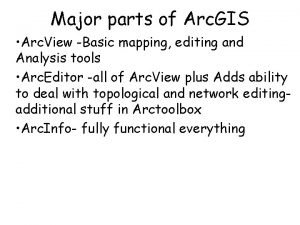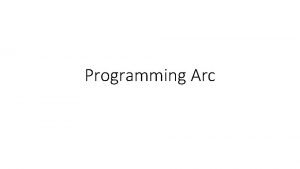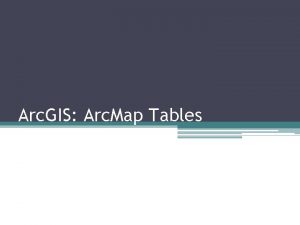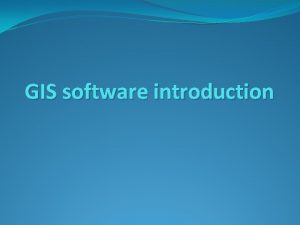Arc GIS Data Models Marine Data Model Dawn

































































- Slides: 65

Arc. GIS Data Models: Marine Data Model Dawn Wright - Oregon State University Pat Halpin - Duke University Michael Blongewicz - DHI Joe Breman - ESRI

Polling Questions • What is your name, organization, and email? – (Add yourself to a data models user group list, and you will be sent notifications about webcasts, design studios, etc. ) • Which of the following ESRI data types do you most commonly use? – a) Coverage – b) Shapefile – c) Geodatabase feature class • Are you interested in seeing a data model webcast, participating in a design studio, and for which data model? • Where on the web do you get data? 2

Agenda • Marine data model overview and tools – – – The use of schema and templates Tools designed and tested with marine data model case studies. Multidimensional modeling. • Model elements – Feature Datasets – Object classes – Relationships • Historical Iterations – Subclasses versus Subtypes • Current Status – Ready to be used – Book coming next year • Presentation of tools and uses of a Marine Geodatabase 3

Thematic Content - layer stack Thematic groupings of marine and oceanographic data sets 4

The Data Modeling Cycle Conceptual, logical, and physical models Real World Objects and Relationships Physical Model Database Schema Business Rules Conceptual Model Sketches, Flow Diagrams, etc. Logical Model Diagram in CASE Tool Arc. Catalog Tools 5

What is a Data Model? • A practical working template • A starting point for creating a geodatabase • An aid to simplify the integration of similar datasets • A way to facilitate the exchange of data • A support to existing standards Geodatabase Point Feature Object. ID Geometry Measurement Computation Land. Object. ID Transaction. ID System. Start. Date Official. End. Date * * * Survey. Point * Survey. Boundary Coordinate Project 6

What’s in a Data Model Template? • A pre-designed schema of Objects • Feature classes • Tables • Relationships • Domains • Subtypes 7

Using a Design Template Schema Wizard reads repository or template to create a geodatabase 8

Arc. GIS Data Models Web site http: //support. esri. com/datamodels • • • Over 25 industry-specific data models Conceptual and logical diagrams Case studies, Tips and Tricks documents 9

Path forward for multi. D modeling • Extend existing functionality to support time and other variables of multidimensional data. – Animation manager used to control variables such as time to set the animation sequence. – Improve quality and interaction of charting and include as an animation object. – Added support for the Net. CDF data format building on existing layer capabilities. – 3 D interpolation 10

Tools - net. CDF at 9. 2 11

Net. CDF in Arc. GIS Can be accessed as: • • • Raster Feature Table Direct read and write GIS data to net. CDF 12

Make net. CDF Raster, Feature (point), and table layers 13

Using Net. CDF as a feature, raster or table in the GIS (network common data format) • Behaves the same as any layer or table in: – Display Same display tools for raster and feature layers will work on net. CDF raster and net. CDF feature layers. – Charting Driven by the table just like any other chart. – Animation Multidimensional data can be animated through a variable (e. g. time, pressure, elevation) – Geoprocessing Tool A net. CDF raster layer will work just like any other raster layer, same for feature layers and tables. 14

Geoprocessing Models Model Builder diagrams for workflow Extract by Rectangle Extract_east Output Extent Raster in WGS 84 Extract by Rectangle (2) Output Extent extract_west Extract by Rectangle (3) Shift Output grid name Shifted_west Mosaic Raster in WGS 84 Output Extent 15

3 D points displayed in volume space 16

3 D Interpolation tool Sample resulting from collaboration between data models and ESRI developer Network (EDN) New tools based on data model prototypes and case study testing. 17

18

19

20

Demo Marine Data Model 3 D interpolation tool 21

Marine Data Model • Overview -Model elements – – – Feature Datasets and feature classes Object classes Relationships • Historical Iterations – Subclasses versus Subtypes • Current Status – Ready to be used – Book coming next year • Presentation of tools and uses of a Marine Geodatabase 22

Feature Data Sets and Feature Classes The Feature data set Stores the spatial reference for all feature classes it contains, including the extents of their m and z values – Feature Classes • Marine Features – Time. Series Points – Instantaneous. Points » Instant, Survey, Sounding, Location. Series – Profile. Line – Shoreline – Track – Time. Duration. Area • Mesh Features – Mesh. Points » Grid. Point, Node. Point – Mesh. Elements • indicates classes covered in detail 23

Object Classes (Tables) – Object Classes • • • Survey. Info - stores parameters of a survey Series - stores the parameters of a series of locations Measuring. Device - stores the parameters of a measuring device Vehicle - stores information about the vehicle being used Cruise - stores information associated to a cruise Parameter - stores the properties of a given parameters Scalar. Quantity - stores magnitude data values Vector. Quantity - stores directional data values Measurement - storing depths related to a specific Measurements Measured. Data - storing data values associated to locations • indicates classes covered in detail 24

Relationships in the model (You may only need to use one or two of these for your individual project) – Relationships • • One Survey can have many Points One Profile. Line can have many Surveys One Cruise can have many Tracks One Mesh. Point can have many Vector. Quantities One Mesh. Point can have many Scalar. Quantities Many Vector. Quantities can have one Parameter Many Scalar. Quantities can have one Parameter • indicates classes covered in detail 25

Classification Historical Iterations – Subclasses versus Subtypes 26

Presentation of tools and uses of the data model – Varying uses and means of adapting the data model 27

Instantaneous Points X – a subclass of Measurement. Point for representing features that are a single observation in time and space – the X, Y coordinates plus a time-stamp create the unique point feature – can have multiple Z locations – an Instantaneous. Point has 4 Subtypes • • 23. 06. 05 18: 00 Y Instant - default value Sounding Survey Location. Series – Example: Bathymetric Survey, CTD Drops, Z 28

Instantaneous. Points. Survey X 23. 06. 05 18: 00 – Survey. ID • foreignkey relating to Survey. Info – Survey. Info • stores properties about the survey – – – Z Y Start. Date End. Date Description Device. ID Track. ID 29

Demo of the Marine Data Model Survey Point Example 30

Profile. Line – a feature class designated for deriving additional along a line. – Properties Has. M and Has. Z are set to TRUE – has a many-to-many relationship with Survey. Info via Survey. Key – one Profile. Line can be associated to many Surveys – many Survey can be associated to many Profile. Lines – Example: Transects, Coastline Evolution 31

The Design and Intent of Profile. Line Inheritance 32

Demo of Marine Data Model Profile. Line Example 33

Time. Series. Point – a subclass of Measurement. Point – fixed in space (X, Y) – multiple Z Values via Measurement Table – Example: Moored Buoy, ADCP 34

Time. Series. Point with Measurements 1 * 35

Design and Intent of Mesh Features – includes feature classes: • Mesh. Element (polygon) • Mesh. Point (points) – includes object classes: • • Mesh - identifies the features making up a Mesh Vector. Quantity - vector values for each point for each time step Scalar. Quantity - scalar values for each point for each time step Parameter - information about a given parameter – Example: 2 D Model results 36

Relationships 37

Demo Marine Data Model Mesh. Point Example 38

Geodatabase Diagrammer Create graphical representation of geodatabase once complete 39

Framework and Publication of: Arc. Marine data model book

Arc. Marine Purpose • Your Geodatabase Template – Data collection at sea/shore … to final geoprocessing, analysis • Control of required data fields, common data structure – Simplify enterprise GIS project implementation • E. g. , cruises, MPA networks, habitat mapping • Program Coding/Application Development – – – • • Common/shared tool development Rapid prototyping Linkage to processing models Data Sharing/Networking “Schooling” in the Gdb 41

Arc. Marine Design Strategy Image modified from original by P. Halpin, Duke 42

Implementation Process Design Engineering Database Engineering Deployment/Rollout • • • Since Oct 2001: 3 workshops, 3 ESRI UC sessions Arc. Marine Interest List: over 350 people, 32 countries Approaching final UML: feature classes, attributes, rules/behaviors Case studies/tool development in 2005 ESRI Press Book in 2006 More info at dusk. geo. orst. edu/djl/arcgis/about. html 43

Arc. Marine: A Geospatial Framework for Ocean and Coastal Analysis • ESRI Press, 2006 – By Wright, Blongewicz, Halpin, Breman • Full background documentation with ~10 case studies • • Chapter 1 - Introduction (Why Arc. Marine? ) Chapter 2 - Conceptual Framework and Common Marine Data Types 44

45

Arc. Marine Thematic Layers 46

Arc. Marine Thematic Layers 47

Arc. Marine … Chapters 3 -6 Marine 48

Ch. 3 - Marine Surveys e. g. , Inst. Points, Time Duration Line, Survey & Cruise object tables Essex MG&G Survey Brian Andrews, USGS-Woods Hole, MA Louisiana Subsidence Heather Mounts, Photo. Science, FL 49

Ch. 4 - Marine Animal Tracking e. g. , Location Series Points, Time Duration Lines and Areas, object tables and rasters OBIS, Pat Halpin et al. , Duke U. Sea Turtle Tracks (Caretta caretta) Sea Surface Temperature (WCR) Source: http: //www. po. gso. uri. edu/SST/ Source: http: //obis. env. duke. edu/datasets/ (Read & Mc. Clellan 2004) 50

Ch. 5 - Time Series & Measurements e. g. , Time Series Points, Profile Line, Time Series/ Meas object tables North Atlantic, Irish Sea Martina Hennesey et al. , Marine Institute, Galway, IRELAND Eamonn Doyle, Rob Morrison, ESRI-IRELAND 51

Ch. 6 - Nearshore & Coastal Analysis e. g. , Shorelines, Profile. Lines, Marine Areas, object tables Martin County, FL Artificial Reefs, Hurricane Tracking Rob Hudson, Photo. Science; Kathy Fitzpatrick et al. , Martin County Govt. 52

Ch. 6 - Nearshore & Coastal Analysis e. g. , Shorelines, Profile. Lines, Marine Areas, object tables Hawaiian Reef Fish and MPAs Alyssa Aaby, UH; Dawn Wright, OSU 53

Ch. 7 - Model Meshes e. g. , finite element Mesh Points, Mesh Elements, Scientific Mesh Juergen Schulz-Olberg, BSH (Federal Maritime & Hydrographic Agency of Germany) Michael Blongewicz, DHI Ch. 8 - Multidimensional GIS e. g. , linking Arc. Marine with Arc. Hydro and other DMs Joe Breman, ESRI; Michael Blongewicz, DHI; Pat Halpin, Duke Ch. 9 - Customizing Arc. Marine especially tools for data import, filter, extraction, synching, modeling Arc. Marine Poster, UML/XMI, Tool Suite on accompanying web site

More information dusk. geo. orst. edu/djl/arcgis includes downloads, new tutorial support. esri. com/datamodels

Arc. Marine Data Model Marine Modeling Applications Implications: Allows explicit spatial & temporal relationships to be used in geoprocessing and analysis Allows for advanced tool development P. N. Halpin 2005 56

Arc. GIS 9. 2… Developments • Model. Builder • Geodatabase Raster Support • Net. CDF support • Python Scripting P. N. Halpin 2005 57

Geospatial tools for marine apps will need to model multiple dimensions with variable data quality… Turtles: Cayman Islands T Z m mm X Y Dive Profiles: ~4 D Data (X, Y, Z, T m…m) P. N. Halpin 2005 58

Geospatial tools for marine apps will need to model time lags… Spatio-Temporal Models At large spatial scales: Marine animal distribution Temporal lags Oceanography (winds, currents) Primary productivity At finer spatial scales: Bathymetric and water temperature gradients Prey availability Marine mammal distribution P. N. Halpin 2005 59

Geospatial tools for marine apps will need to model events… Spatio-Temporal Models SST in Mid-Atlantic Time 2003 -05 Marine mammal distribution “Persistent” SST Event 2003 -04 2003 -03 2003 -02 2003 -01 2002 -12 P. N. Halpin 2005 Space Statistical modeling approach will allow for “antecedent” oceanographic conditions to be used to more accurately predict potential habitat. 60

Geospatial tools for marine apps will need to forecast… The emerging management applications are at these finer temporal scales… P. N. Halpin 2005 61

Geospatial tools for marine apps will need to integrate multivarite statistical models… Integrating statistical models Arc. Rstats Multivariate Modeling Script for Arc. GIS This script can be used with Arc. GIS to produce predictive maps based on different techniques using the free and robust R statistical package: • Generalized Linear Model (GLM) • Generalized Additive Model (GAM) • Classification and Regression Tree (CART) Best, B. D. , S. Loarie, S. Qian, P. Halpin, D. Urban, 2005. Arc. Rstats - multivariate habitat modeling with Arc. GIS and R statistical software. Available at http: //www. nicholas. duke. edu/geospatial/software. 62

Geospatial tools for marine apps will need to integrate multivarite statistical models… Benthic habitat affinity models Predicted Blue Rockfish habitat area P. N. Halpin 2005 63

Geospatial tools for marine apps will need to automate time series data acquisition & processing… Sampling through time and data layers… Observation data Net. CDF or HDF imagery Python script 1998 -07 -01 SST Chl 1998 -07 -02 1998 -08 Depth 1998 -07 -03 1998 -07 -04 P. N. Halpin 2005 tim e 64

Arc. Marine Data model and tool development Geodatabase model structure will help with… • Multivariate statistical models • Temporally dynamic data acquistion & sampling • Time sensitive predictions Data model standardization will promote usability of common tools and extensions… P. N. Halpin 2005 65
 Arc view gis
Arc view gis Arc gis
Arc gis Arc gis map
Arc gis map Arc gis map
Arc gis map Fish map
Fish map Arc gis
Arc gis Arc gis explorer
Arc gis explorer Arc gis 10
Arc gis 10 Arc promoteur vs arc investigateur
Arc promoteur vs arc investigateur Minor arc and major arc
Minor arc and major arc Mior arc
Mior arc Arc emu88 com arc info 37 100037 html
Arc emu88 com arc info 37 100037 html Enterprise data mashup
Enterprise data mashup Data mashups and gis are data integration technologies.
Data mashups and gis are data integration technologies. Modals and semimodals
Modals and semimodals Output device for gis
Output device for gis What are the most common data input techniques in gis
What are the most common data input techniques in gis Big data and gis
Big data and gis Component of gis
Component of gis Gis data structure
Gis data structure Gis data structure
Gis data structure Data quality in gis
Data quality in gis Gis data validation
Gis data validation Giscont
Giscont Data quality in gis
Data quality in gis Data quality in gis
Data quality in gis Gis data input
Gis data input Gis data validation
Gis data validation Polk county gis map viewer
Polk county gis map viewer Gis data types
Gis data types Attribute data query in gis
Attribute data query in gis Limb arc model
Limb arc model The dawn of victorian age zanichelli
The dawn of victorian age zanichelli At dawn the ridge emerges massed and dun
At dawn the ridge emerges massed and dun Thick awe loved hoot he
Thick awe loved hoot he Phoebe prince
Phoebe prince October dawn analysis
October dawn analysis Wand her womb hen
Wand her womb hen Louise nevelson dawn's wedding chapel iv
Louise nevelson dawn's wedding chapel iv Dawn corbett nih
Dawn corbett nih Owenexposure
Owenexposure Uc berkeley song
Uc berkeley song Dawn fenomeni ve somogy etkisi
Dawn fenomeni ve somogy etkisi Dawn marie's dream
Dawn marie's dream Non classical adrenal hyperplasia
Non classical adrenal hyperplasia Bacrea
Bacrea At dawn the ridge emerges massed and dun
At dawn the ridge emerges massed and dun Was sally ann thunder ann whirlwind a real person
Was sally ann thunder ann whirlwind a real person When dawn spread out her fingertips of rose
When dawn spread out her fingertips of rose Ripley dynamics
Ripley dynamics Siriraj score
Siriraj score Men's voices ireland
Men's voices ireland Stanislas limousin contribution to pharmacy
Stanislas limousin contribution to pharmacy Dr dawn johnson
Dr dawn johnson Dawn of mass culture
Dawn of mass culture Dr dawn phillips
Dr dawn phillips Bride of the dawn chapter 8
Bride of the dawn chapter 8 Book 9 odyssey
Book 9 odyssey Target state architecture
Target state architecture Dawn buehler
Dawn buehler The pickety fence poem
The pickety fence poem Dawn meyerriecks
Dawn meyerriecks Jillian and dawn are playing a game
Jillian and dawn are playing a game Indian horse summary chapter 1-10
Indian horse summary chapter 1-10 Caged bird poem metaphor
Caged bird poem metaphor Moravian accelerated nursing program
Moravian accelerated nursing program
